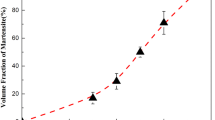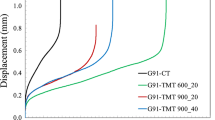Abstract
Studies on creep behaviour of austenitic steels as a function of metallurgical variables like: (a) extent of cold work (b) trace alloying elements (c) choice of joining method indicate the need to understand their role through microstructural studies. As the materials evolve during creep exposure in terms of defect structure and precipitation behaviour, extensive electron microscopy studies were carried out to understand the influence of the above variables. It was observed that cold work shows an increase in creep life as it is varied from 10 to 24 % due to the enhanced prior defect structure providing a complex tangled dislocation structure when the material undergoes creep deformation. The addition of Ti results in enhanced nanoscale precipitation of TiC which was found to influence the creep strength up to 0.23 % of Ti. Employing modified TIG joining over the conventional TIG process it has been found less creep cavitation in the former joint which led to the improvement in creep rupture strength. The paper would discuss in detail of the microchemical variations, microstructural evolution in terms of defect structure and precipitation behaviour on the creep life.








Similar content being viewed by others
References
Dietz W, in Materials Science and Technology: A Comprehensive Treatment, (eds) Cahn R W, Haasen P, Kramer E J, and Weinheim V C H (1994), 10B:p123.
Selection of Materials for PFBR Nuclear Steam Supply System Components—Technical Note # PFBR-MDG-2002-01, Kalpakkam (2002).
Pawar S, Goel D B, and Pandey O P, Bull Mater Sci 28 (2005) 259–265.
Latha S, Mathew M D, Parameswaran P, Bhanu Sankara Rao K, and Mannan S L, Int J Press Vessels Pip 85 (2008) 866–870.
Vasudevan M, Venkadesan S, and Sivaprasad P V, J Nucl Mater 231 (1996) 231–241.
Sakthivel T, Vasudevan M, Laha K, Parameswaran P, Chandravathi K S, and Mathew M D, Mater Sci Eng A 528 (2012) 6971–6980.
Vijayanand V D, Parameswaran P, Nandagopal M, Panneer Selvi S, Laha K, and Mathew M D, J Nucl Mater 438 (2013) 51–57.
Padilha A F, Plaut R L, Rios P R, ISIJ Int Jpn 43(2003) 135–143.
Weiss B, and Stickler R, Metall Trans 3 (1972) 851–866.
Acknowledgments
The authors thank Dr. S. Venugopal, Director, Metallurgy and Materials Group & Dr. M. Vijayalakshmi, Associate director, Physical Metallurgy Group, Indira Gandhi Centre for Atomic Research, Kalpakkam, India for their continual support for the present work. The authors thank the contributions of Sri. T. Sakthivel, Dr. S. Latha, Sri. V.D. Vijay Anand and Dr. M. Vasudevan.
Author information
Authors and Affiliations
Corresponding author
Rights and permissions
About this article
Cite this article
Parameswaran, P., Laha, K. & Mohandas, E. Microstructural Studies in Understanding the Role of Metallurgical Parameters on Creep Behaviour of Austenitic Alloys. Trans Indian Inst Met 69, 235–239 (2016). https://doi.org/10.1007/s12666-015-0792-5
Received:
Accepted:
Published:
Issue Date:
DOI: https://doi.org/10.1007/s12666-015-0792-5




